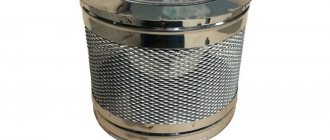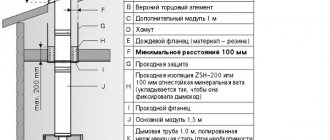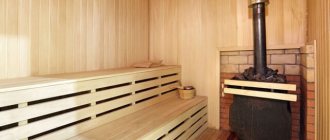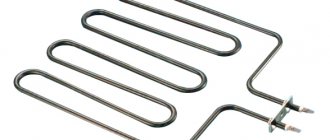Hello, dear guest!
Sit back and forget about your pressing problems for a moment. The topic of today’s article is one of the favorite vacation spots of Russian people. A place where people have long washed themselves, treated illnesses, met with friends, and simply hid for a while from life’s hardships.
Have you already guessed what I mean? Right! Today we will talk about the Russian bathhouse. About a classic bathhouse, but made in modern solutions, comfortable and safe. We will take a detailed look at the tank on a bath pipe, find out why it is needed, in which cases this option for heating water is optimal, and find out the dangers of choosing the wrong bath containers.
Why do you need a tank on a pipe?
Strong hot steam, invigorating tart aroma of wood, birch and juniper brooms, the special spirit of a Russian bath... Not a single sauna with scalding air can replace real light steam! Even in our time, a bathhouse is a favorite place to relax for a person tired of the everyday hustle and bustle. And no entertainment and shopping centers will replace it.
And now I’ll add a little horror to the beautiful picture.
Imagine - you have decided to build or renovate a bathhouse. And so, the walls are covered with new lining, fresh brooms are waiting for hot steam, and the simplest thing remains - to buy a tank for the sauna stove. It would seem, what could be simpler?
Modern stores are overflowing with bath accessories and there are a great variety of containers for heating water. Most are tanks for sauna stoves of various shapes, shiny, smooth to the touch, with high-quality and beautiful welds. It would seem, what else is needed?
Now let's take a closer look at the material of manufacture.
In 80% of cases it is stainless steel with the incomprehensible name AISI430. And few people know that the stainless steel in this AISI is only a shiny surface and a little chrome. And a sheet of such material burns out under the influence of direct fire in 3-4 months. It’s no wonder that the manufacturer’s warranty for such tanks is no more than 3 months. Moreover, the sheet thickness is rarely more than one and a half millimeters.
And this is where the fun begins. Imagine, you bought a tank for 10, 15, or even 30 thousand rubles and happily installed it on the stove in the bathhouse. And six months later a hole burned in the bottom. Scary?
So I'm scared.
But there is a great way to avoid all such troubles, even using products made from Chinese stainless steel. And one of them is installing a water tank directly on the sauna pipe.
Heat exchangers in the furnace
Heat exchangers in the furnace
With the help of such heat exchangers, the water will heat up much faster. Heat exchangers in a furnace can be made of tubes in the form of various geometric designs or be ordinary flat. The efficiency of flat-plate heat exchangers is lower. But they are much more durable and easier to manufacture.
Flat-plate heat exchanger
Heat exchangers must be installed simultaneously with the laying of the furnace. Taking into account the parameters of the firebox, the dimensions of the heat exchangers are selected. The pipe outlets can be either on one side of the furnace or on both. The option of cold water entering from below and exiting from above the plane of the furnace is allowed. In a word, there are a great many options both in terms of the heat exchanger material, type, geometry, linear dimensions and design features. It is impossible to give unambiguous universal advice; you must make your own decision, taking into account the characteristics of the sauna stove and the modes of use of the shower and steam room.
The heat exchanger is installed simultaneously with the furnace laying
To make a heat exchanger, choose durable, high-quality materials; welding seams must be made in accordance with the rules and characteristics of the materials. Keep in mind that in many cases it is impossible to fix a damaged heat exchanger in a furnace without disassembling it. It’s not worth explaining what it means to disassemble and reassemble a stove.
The easiest option is to purchase a factory-made metal sauna stove with a built-in heat exchanger. But such furnaces have one drawback - the low efficiency of the heat exchanger.
Furnace with heat exchanger
The principle of operation of a tank on a pipe
The first Russian baths were heated “black”; smoke filled the room, leaving traces of soot and soot on the walls. This technology has long been a thing of the past; modern stoves are equipped with chimneys.
Vapors and gases leaving the stove through the chimney heat it up greatly. And this temperature can be used to heat water.
To do this, a tank is installed on the pipe. It encircles the pipe and the water in it is heated by hot gases. This solves two problems at once - heating water and thermal insulation of pipes.
This is interesting: This system works on the principle of a samovar, which is why the tank on the pipe is called a samovar.
Pros and cons of this design
The main advantages of installing a sauna tank on a pipe:
- The reservoir can be placed along the entire length of the pipe, which allows you to obtain a large volume of hot water. At the same time, increasing the volume of the container will not affect the heating time;
- The temperature of the gases in the pipe is high (up to 500 degrees), so heating is carried out quickly and evenly;
- Installing the tank is easy to do with your own hands;
- Hot smoke is not just discharged into the street, but heats the water, so the efficiency of the stove increases;
- The service life of the chimney increases;
- The water maintains its temperature for a long time while the pipe cools;
- No additional heating elements are required;
- The samovar tank can be installed not in the steam room itself, but at the attic level. In this case, hoses are connected to the heat exchanger to input cold water and output hot water.
Design disadvantages:
- Large tanks are difficult to install due to weight. If it is necessary to install a large container, it is necessary to use a fastening system, and the load should not fall on the stove, but on the walls or foundation;
- The water temperature cannot be controlled;
- The liquid boils away faster;
- The design is not suitable for every chimney. For example, if the pipe in the bathhouse is brick or asbestos, you will have to choose another option;
- If the heat exchanger is located high, it is difficult to fill it with water.
Important! In the cold season, the liquid from the tank must be drained, otherwise the entire system will freeze.
Air type register
The main purpose of the heat exchanger is to transfer energy from the combustion products in the chimney to the coolant, which is water or air. Heat exchangers installed in chimneys (this applies to water modifications) are often called economizers.
These devices collect and transmit heat into the room, which simply goes into the atmosphere, so that the thermal energy generated by the furnace is used to the maximum. In addition to ordinary tap water, other liquids are sometimes used - oil or anti-freeze.
In this regard, all devices are divided into two large categories:
- air;
- liquid (water).
The choice of one type or another depends on several factors. The most important of them are the configuration and material of the chimney, as well as the characteristics of the device itself.
Air heat exchanger diagram. It is considered less efficient than its liquid counterpart, but has a simple design, making it suitable for DIY
Some partitions (dampers) are not soldered, but made movable. By sliding the metal plates in/out, you can adjust the traction force, thereby reducing or increasing the performance of the heating device.
Air heat exchangers are called convectors, since their operation is based on the principle of convection. Cold air from the room enters the device, where its temperature rises due to the influence of hot flue gases. When heated, it moves further through another hole - back into the room or into the heating system.
Types of factory tanks and average prices
Factory tanks have different configurations. Main parameters:
- Type of material;
- Design;
The most common materials are galvanized, steel, stainless steel, less common are products made of cast iron.
The most popular factory shape is a rectangle and a cylinder with a circular cross-section.
Average cost of a rectangular tank with a volume of 50 liters:
- Steel - 1000 rubles;
- Galvanizing - 1500-2000 rubles;
- Stainless steel - from 3000 rubles.
How to choose?
To begin with, you need to decide where the tank will be located - directly above the pipe, or it will be a remote structure located in the attic.
Installing a container in the attic is convenient, but not always possible - it all depends on the design of the roof and the possibility of supplying and discharging water.
Calculating the volume
The required volume of liquid is calculated from the norm of 15-20 liters per person plus 10-15 liters in reserve. For example, if a family of 2 people periodically washes in a bathhouse, then a tank of 50 liters will be enough. A family of 4 people will need a capacity of 80-100 liters.
Type of material
Pros and cons of steel, cast iron, stainless steel:
- Cast iron
Cast iron containers are heavy, they are inconvenient to install, the water in them heats up slowly, but remains hot for a long time;
- Galvanized iron
Containers made from it last longer than steel ones, but over time they rust and burn out;
- Steel
Due to their high thermal conductivity, steel tanks heat up quickly and cool down just as quickly. The main advantage is the price, the main disadvantage is the low service life;
- Stainless steel
They combine all the advantages of iron products with high corrosion resistance.
Enameled products are found in stores. They are more durable than uncoated steel tanks, but are susceptible to chips, in place of which pockets of corrosion form.
Features of installation and connection step by step
It is not difficult to install a water tank with your own hands.
Let's look at each stage separately:
- If the stove is already installed, remove the section of pipe extending from the stove into the ceiling;
- We weld a piece of pipe 8-10cm long to the outlet of the furnace.
- If the pipe built into the tank does not match the diameter of the chimney, an adapter is mounted on the installed section of the pipe;
- We install the tank. The distance between the top cover and the ceiling should be 20-25cm;
- If necessary, an adapter is also installed in the upper part;
Important! Pipe connections are made using crimp clamps, but the joints should be additionally treated with a special sealant. Otherwise, if gases penetrate through cracks in pipe joints and there is insufficient ventilation, a person may suffocate.
A few important operating rules:
- The bathhouse is not only a recreation area, but also a place of increased danger, especially for children. Therefore, if possible, it is better to install the tank on the pipe as high as possible, optimally in the attic. You need to pour boiling water extremely carefully.
- The system should be filled with water until it is flooded; heat without water will destroy the welds.
- Do not leave water in cold weather. If the water in the system freezes, deformation is inevitable.
Power calculations
All calculations will always be approximate; in each individual case it is difficult to determine the power that will be required to heat a room, steam room, etc.
It is generally accepted that no more than 5 kW is enough to heat an ordinary bathhouse. For example, 1 sq. m of heat exchanger (its area) is equal to 9 kW of the furnace. Keep in mind that the power will be significantly reduced after the furnace or boiler goes out, so the calculation must be made based on the surface of the furnace heat exchanger. Therefore, when calculating, try to take into account the maximum area of the heat exchanger to ensure sufficient temperature even with a one-time fire.
The shape in this case practically does not matter; it can be as different as you like. A register made of stainless steel pipes is considered the most optimal, but gradually its place is taken by a welded manifold made of two channels. A heat sink of this shape is considered less easily produced, but it does not require a lot of material for its installation and installation.
Also, do not forget to take into account the type of chimney itself; it is quite difficult to install a high-quality heat exchanger on brick chimneys, unlike metal ducts. Therefore, when giving preference to independent work, proceed from convenience.











